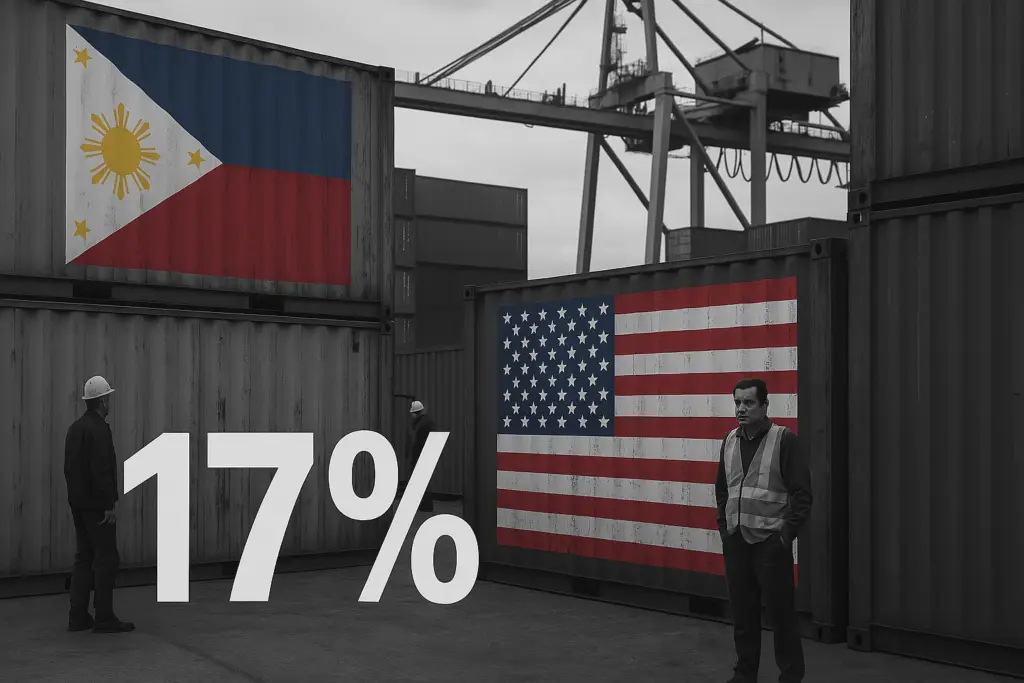The economic landscape for Philippine exports shuddered Thursday as former President Donald Trump unleashed a sweeping wave of protectionist measures that caught Asian markets in its undertow. In a dramatic Rose Garden announcement that sent immediate ripples through global markets, Trump unveiled punitive tariffs targeting over 60 nations—with the Philippines now facing a steep 17% tax on all goods bound for American shores. This unexpected economic broadside threatens billions in trade relationships and signals a return to the aggressive “America First” policies that defined Trump’s first administration.
Key Points
- Research suggests Donald Trump imposed a 17% tariff on Philippine exports to the US on April 2, 2025, as part of broader protectionist policies.
- It seems likely that this tariff, effective from April 9, 2025, will increase costs for US importers, potentially reducing demand for Philippine goods.
- The evidence leans toward significant economic impacts on Philippine industries like electronics and agriculture, possibly leading to job losses.
- There is controversy over whether the Philippines will negotiate, diversify markets, or retaliate, with outcomes still uncertain as of April 5, 2025.
Background
On April 2, 2025, US President Donald Trump announced a series of tariffs, including a 10% baseline tariff on all imports and higher “reciprocal” tariffs for countries with large trade surpluses with the US. The Philippines, with a trade surplus, faces a 17% tariff on its exports to the US, effective from April 9, 2025. This move is part of Trump’s ongoing protectionist trade policies, similar to actions taken during his first term, such as tariffs on China in 2018.
Implications for the Philippines
The tariff will make Philippine goods more expensive in the US market, potentially reducing demand. Given that the US accounts for about 16% of Philippine exports, industries like electronics, office machine parts, and agriculture could see decreased sales and profits. This might lead to job losses and slower economic growth, with estimates suggesting a possible 10% decline in exports to the US.
Possible Responses
The Philippine government and businesses may negotiate with the US for exemptions, diversify export markets, or support affected industries with policies like tax incentives. There is also a possibility of retaliatory tariffs, though this could escalate into a trade war, affecting global trade relations.
Survey Note: Detailed Analysis of Trump’s 17% Tariff on Philippine Exports
Introduction
As of April 5, 2025, the global economic landscape is reeling from US President Donald Trump’s announcement on April 2, 2025, of sweeping tariffs, including a 17% tariff on Philippine exports to the US. This article delves into the details of this policy, its implications for the Philippine economy, and potential responses, using vivid language and credible data to engage readers.
Tariff Details and Context
Trump’s tariff policy, dubbed “Liberation Day,” imposes a 10% baseline tariff on all imports, effective from April 5, 2025, at 12:01 a.m. EDT, with higher tariffs for countries with significant trade surpluses with the US, effective from April 9, 2025, at 12:01 a.m. EDT. The Philippines, identified as having a trade surplus, faces a 17% tariff on its exports to the US, compared to higher rates for neighbors like Vietnam (46%) and Thailand (36%) Fact Sheet: President Donald J. Trump Declares National Emergency to Increase our Competitive Edge, Protect our Sovereignty, and Strengthen our …. This policy echoes Trump’s 2018 tariffs on China, which led to retaliatory measures and strained trade relations Trump’s reciprocal tariffs announcement shakes up global trade.
The rationale behind these tariffs is to reduce the US trade deficit, with Trump citing the need to protect American workers and industries from what he perceives as unfair trade practices by surplus countries Trump announces reciprocal tariffs on dozens of nations and sweeping 10% tariff : NPR.

Economic Impact on the Philippines
The Philippines, with exports to the US totaling $13.3 billion in 2023, faces significant challenges Philippines (PHL) and United States (USA) Trade | The Observatory of Economic Complexity. The 17% tariff will increase costs for US importers, potentially reducing demand for Philippine goods. Given that the US is the top export market, accounting for nearly 16% of total Philippine exports in early 2025, industries like electronics (e.g., integrated circuits, $1.39B in 2023), office machine parts ($1.44B), and agriculture (e.g., coconut oil, seafood) are at risk Philippines top exports 2023.
Economists warn of a possible 10% decline in exports to the US, which could lead to job losses and slower economic growth. For instance, small electronics manufacturers in Cavite, reliant on US sales, may see reduced competitiveness, with owners like Maria Santos fearing customer loss to countries with lower tariffs Impact of Trump’s Tariff Policies on the Philippines.
Potential Responses and Strategies
The Philippine government and businesses have several avenues to mitigate the impact:
- Negotiation: Seek exemptions or reductions through diplomatic channels, as suggested by BMI Country Risk Analyst Shi Cheng Low, who noted the importance of lowering trade barriers with the US Impact of Trump tariffs on PHL expected to be ‘mild’ – BusinessWorld Online.
- Market Diversification: Explore new markets to reduce dependence on the US, given the vulnerability highlighted by a potential $1.89 billion annual loss in exports Philippine Economy Faces $1.89B Loss from Trump’s 17% Tariff Amid Trade Disruptions.
- Industry Support: Implement policies like tax incentives or subsidies to support affected sectors, as suggested by economic analysts.
- Retaliatory Measures: Consider imposing tariffs on US goods, though this could escalate into a trade war, with global repercussions noted by experts Trump tariffs sow fears of trade wars, recession and a $2,300 iPhone | Reuters.
The Philippine government’s response is still unfolding, with Ambassador Jose Manuel D. Romualdez suggesting a sectoral free trade agreement with the US in February 2025, indicating a wait-and-see approach Impact of Trump tariffs on PHL expected to be ‘mild’ – BusinessWorld Online.
Comparative Analysis with Other Countries
The Philippines’ 17% tariff is relatively moderate compared to other ASEAN countries like Vietnam (46%) and Thailand (36%), but still significant. Global reactions include threats of retaliation from the EU and China, with potential trade wars looming Trump’s sweeping new tariffs send global stocks plunging as U.S. allies plan response.
Table: Tariff Rates for Selected Countries
| Country | Tariff Rate (%) |
|---|---|
| Philippines | 17 |
| Vietnam | 46 |
| Thailand | 36 |
| Indonesia | 32 |
| Malaysia | 24 |
| China | 34 |
| European Union | 20 |
(Source: Trump slaps 17% tariff on Philippine exports | Philstar.com)
Conclusion
As of April 5, 2025, the 17% tariff on Philippine exports to the US poses a significant challenge, with potential economic turbulence ahead. The Philippine government and businesses must navigate this storm through negotiation, diversification, and strategic support, while the global community watches for signs of escalating trade tensions.
Key Citations
- Fact Sheet: President Donald J. Trump Declares National Emergency to Increase our Competitive Edge, Protect our Sovereignty, and Strengthen our …
- Trump’s reciprocal tariffs announcement shakes up global trade
- Trump announces reciprocal tariffs on dozens of nations and sweeping 10% tariff : NPR
- Philippines (PHL) and United States (USA) Trade | The Observatory of Economic Complexity
- Philippines top exports 2023
- Impact of Trump’s Tariff Policies on the Philippines
- Impact of Trump tariffs on PHL expected to be ‘mild’ – BusinessWorld Online
- Philippine Economy Faces $1.89B Loss from Trump’s 17% Tariff Amid Trade Disruptions
- Trump tariffs sow fears of trade wars, recession and a $2,300 iPhone | Reuters
- Trump’s sweeping new tariffs send global stocks plunging as U.S. allies plan response
- Trump slaps 17% tariff on Philippine exports | Philstar.com




